Top 20 Most Beautiful Buildings In The World
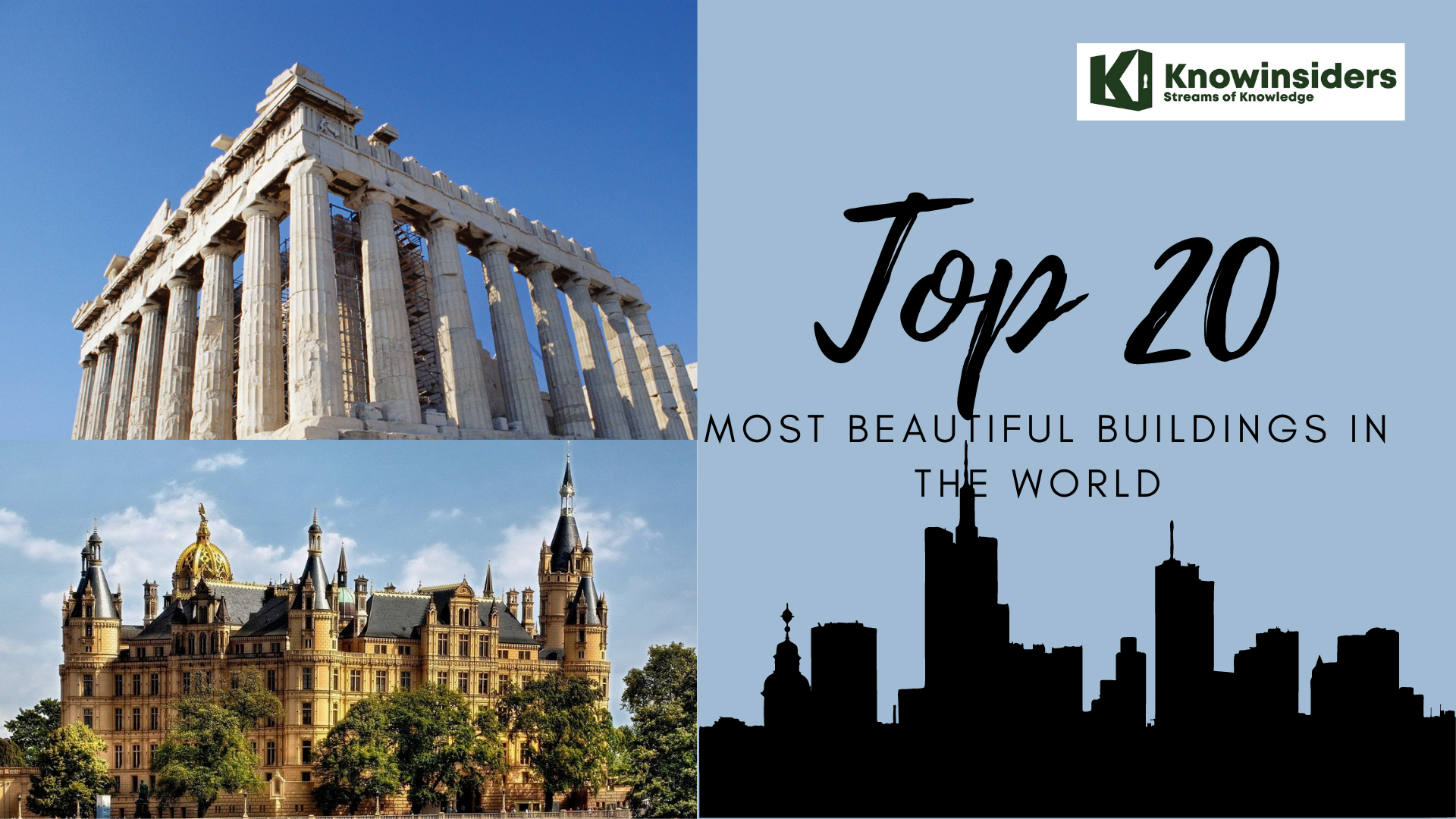 |
| Top 20 most beautiful buildings in the world |
Even though sightseeing themost beautiful buildings in the world may not be the first reason why you travel to the other side of the globe, you must acknowledge that stunning architecture is for sure exciting.
Certain buildings carry a lot of cultural heritage, and paying attention to a destination’s architecture helps you learn more about the history of the place.
So if you’re an architecture enthusiast or just an innate curious traveler, this post is for you. We’ll take you on a tour around the most impressive architecture on the globe. From the ancient Great Pyramid of Giza, in Egypt, to the gorgeous Moorish-style Royal Alcazar in Seville, Spain, here are the top 20 most impressive architecturalbuildings on earth.
List of top 20 most beautiful buildings in the world
20. Palace of Versailles, France
19. Taj Mahal, India
18. Neuschwanstein Castle, Germany
17. Semperoper Dresden, Germany
16. Mont Saint-Michel Abbey, France
15. Senedd, Wales
14. Hungarian Parliament, Hungary
13. Florence Cathedral, Italy
12. Notre Dame de Paris, France
11. The Louvre Museum, France
10. Schwerin Palace, Germany
9. Parthenon, Greece
8. Freebooter, Netherlands
7. Saint Basil’s Cathedral, Russia
6. Tower of Pisa, Italy
5. Lotus Temple, India
4. Cologne Cathedral, Germany
3. Winter Palace, Russia
2. Burj Khalifa, Dubai
1. Metropolitan Cathedral of Brasília, Brazil
The top 10 most beautiful buildings in the world in detail
20. Palace of Versailles, France
 |
| Photo: Chateau de versailles |
In 1789, the French Revolution forced Louis XVI to leave Versailles for Paris. The Palace would never again be a royal residence and a new role was assigned to it in the 19th century, when it became the Museum of the History of France in 1837 by order of King Louis-Philippe, who came to the throne in 1830. The rooms of the Palace were then devoted to housing new collections of paintings and sculptures representing great figures and important events that had marked the History of France. These collections continued to be expanded until the early 20th century at which time, under the influence of its most eminent curator, Pierre de Nolhac, the Palace rediscovered its historical role when the whole central part was restored to the appearance it had had as a royal residence during the Ancien Régime.
The Palace of Versailles never played the protective role of a medieval stronghold. Beginning in the Renaissance period, the term "chateau" was used to refer to the rural location of a luxurious residence, as opposed to an urban palace. It was thus common to speak of the Louvre "Palais” in the heart of Paris, and the "Château” of Versailles out in the country. Versailles was only a village at the time. It was destroyed in 1673 to make way for the new town Louis XIV wished to create. Currently the centrepiece of Versailles urban planning, the Palace now seems a far cry from the countryside residence it once was. Nevertheless, the garden end on the west side of the Estate of Versailles is still adjoined by woods and agriculture.
19. Taj Mahal, India
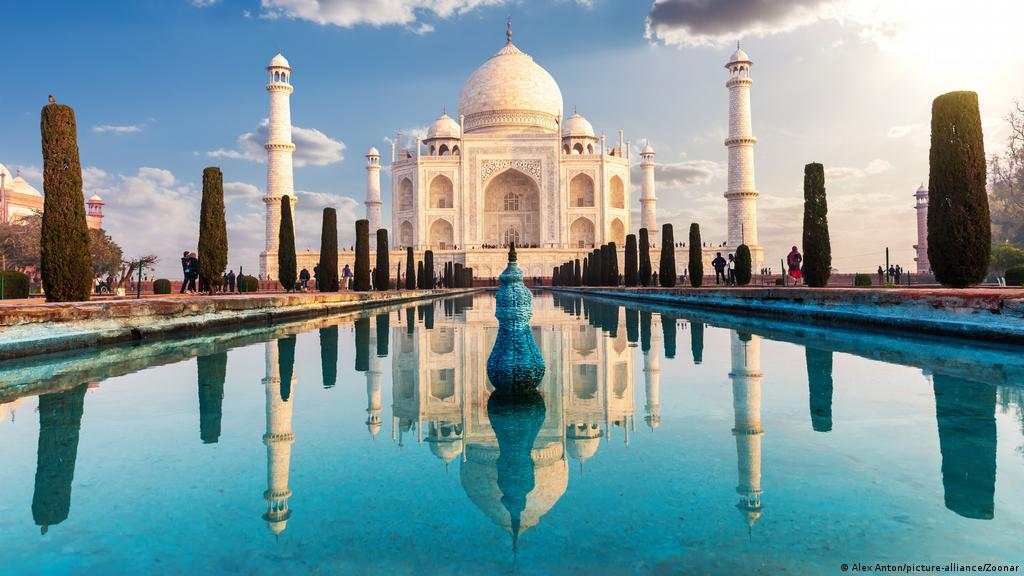 |
| Photo: DW |
Taj Mahal, also spelled Tadj Mahall, mausoleum complex in Agra, western Uttar Pradesh state, northern India. The Taj Mahal was built by the Mughal emperor Shah Jahān (reigned 1628–58) to immortalize his wife Mumtaz Mahal (“Chosen One of the Palace”), who died in childbirth in 1631, having been the emperor’s inseparable companion since their marriage in 1612. India’s most famous and widely recognized building, it is situated in the eastern part of the city on the southern (right) bank of the Yamuna (Jumna) River. Agra Fort (Red Fort), also on the right bank of the Yamuna, is about 1 mile (1.6 km) west of the Taj Mahal.
In its harmonious proportions and its fluid incorporation of decorative elements, the Taj Mahal is distinguished as the finest example of Mughal architecture, a blend of Indian, Persian, and Islamic styles. Other attractions include twin mosque buildings (placed symmetrically on either side of the mausoleum), lovely gardens, and a museum. One of the most beautiful structural compositions in the world, the Taj Mahal is also one of the world’s most iconic monuments, visited by millions of tourists each year. The complex was designated a UNESCO World Heritage site in 1983.
18. Neuschwanstein Castle, Germany
 |
| Photo: Swedish Nomad |
Seven weeks after the death of King Ludwig II in 1886, Neuschwanstein was opened to the public. The shy king had built the castle in order to withdraw from public life – now vast numbers of people came to view his private refuge.
Today Neuschwanstein is one of the most popular of all the palaces and castles in Europe. Every year 1.4 million people visit "the castle of the fairy-tale king". In the summer around 6,000 visitors a day stream through rooms that were intended for a single inhabitant.
The setting of Neuschwanstein could not be more idyllic. However, movement in the foundation area has to be continuously monitored, and the sheer rock walls must be repeatedly secured. The harsh climate also has a detrimental effect on the limestone façades, which will have to be renovated section by section over the next few years.
17. Semperoper Dresden, Germany
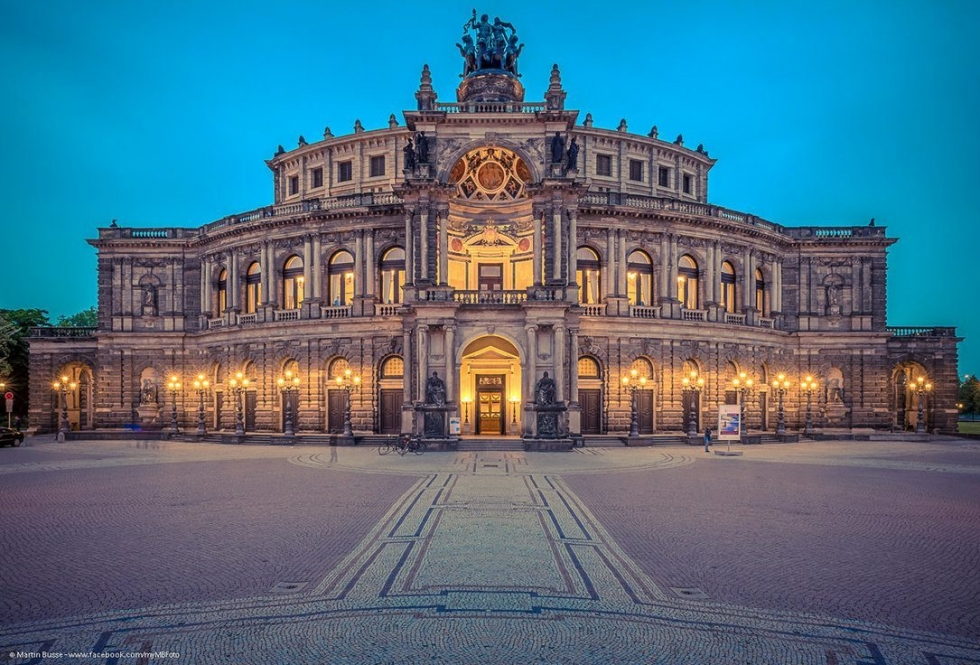 |
| Photo: PandoTrip |
The history of opera in Dresden goes back to the opening of the city’s first opera house in 1667. Under the baton of Hofkapellmeister Johann Adolph Hasse, Dresden rose to prominence as a lively centre of European opera.
When the Royal Saxon Theatre opened its doors in 1817, audiences could enjoy Italian and (somewhat later) German opera in addition to drama. Carl Maria von Weber headed the so-called German Department. »Rienzi«, »The Flying Dutchman« and »Tannhäuser« all premiered here after Richard Wagner’s appointment as Hofkapellmeister in 1843. Ernst von Schuch, who was Generalmusikdirektor from 1889 to 1914, conducted over 40 world premieres, including Richard Strauss’s »Salome«, »Elektra« and »Der Rosenkavalier«. Five more of the composer’s operas were premiered in Dresden up to the year 1938. Under Schuch’s successor, Fritz Busch, the repertoire in Dresden was expanded to include modernist works, such as the world premieres of pieces by Weill and Hindemith.
The Staatskapelle Dresden, one of the most world’s most prestigious orchestras, was founded in 1548. Its principal conductors and music directors have included Karl Böhm, Kurt Sanderling, Herbert Blomstedt, Giuseppe Sinopoli, Bernard Haitink and Fabio Luisi. Christian Thielemann has been principal conductor of the Staatskapelle since 2012.
Aaron S. Watkin has been director of Semperoper Ballett since 2006. He has promoted a diverse repertoire ranging from traditional narrative ballets to contemporary dance, setting international standards with a select group of brilliant soloists.
After Gottfried Semper’s first theatre from 1841 burned down in 1869, the opera was opened in its present design in 1878. When this building was destroyed by the air raids of 1945, Saxon State Opera became “homeless” until the reconstructed Semperoper was officially opened in 1985.
Wolfgang Rothe has been commercial director of the Semperoper Dresden since 2005, and since January 2013 has also been in charge of Saxon State Theatres, an institution created out of the former State Opera and State Theatre. From 2012 to 2018 Wolfgang Rothe was also acting managing director of the Semperoper.
Since the 2018/19 season, Peter Theiler from Switzerland has taken over the reins as managing director of the Semperoper.
16. Mont Saint-Michel Abbey, France
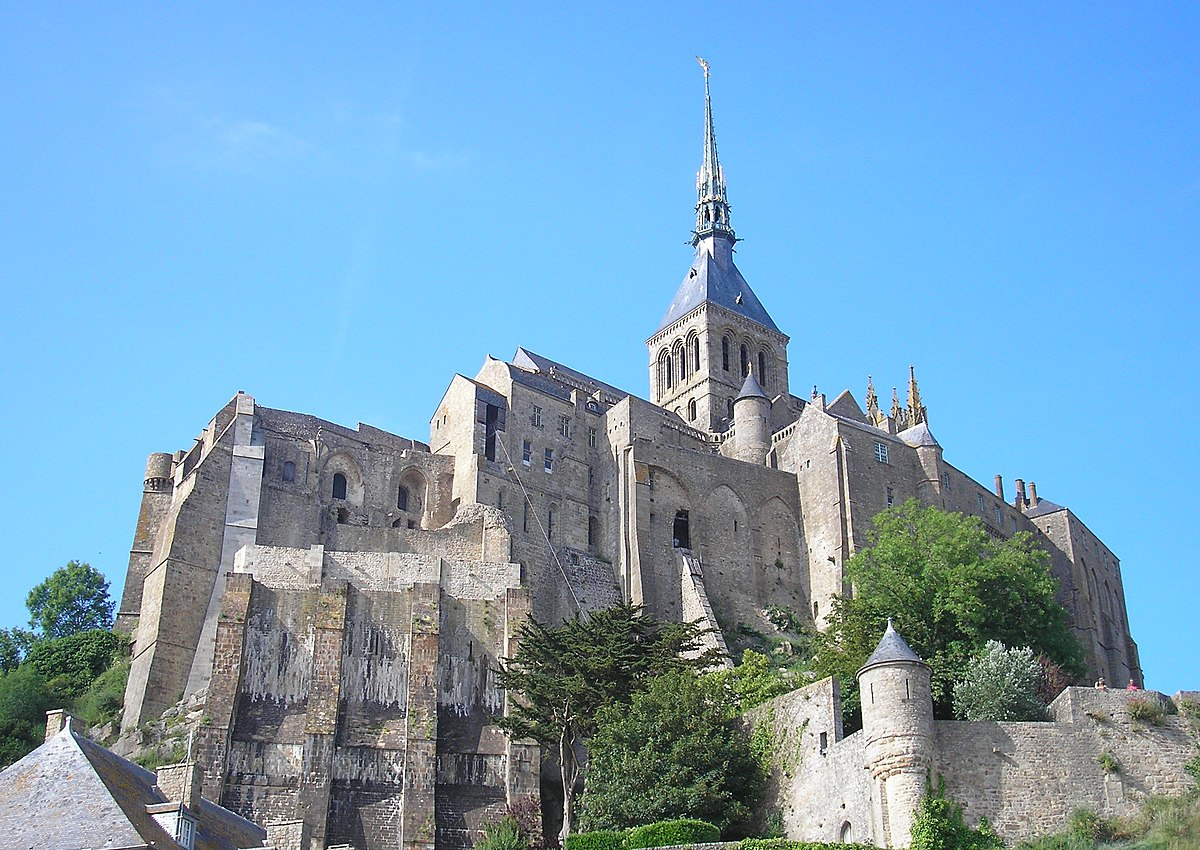 |
| Photo: Wikipedia |
The Mont-Saint-Michel is one of Europe’s most unforgettable sights. Set in a mesmerising bay shared by Normandy and Brittany, the mount draws the eye from a great distance.
This staggeringly beautiful location has long captured the imagination. The story of how the mount came to be a great Christian pilgrimage site dates back to the early 8th century, when Aubert, bishop of the nearby hilltop town of Avranches, claimed that the Archangel Michael himself had pressured him into having a church built atop the island just out to sea.
From 966 onwards, the dukes of Normandy, followed by the French kings, supported the development of a major Benedictine abbey on Mont-Saint-Michel. Magnificent monastic buildings were added throughout the Middle Ages, one vertiginous wing in particular being nicknamed the Marvel. The Abbey of the Mont-Saint-Michel became a renowned centre of learning, attracting some of the greatest minds and manuscript illuminators in Europe. Vast numbers of pilgrims visited, despite endless cross-Channel conflict; in fact, the ramparts at the base of the island were built to keep the English forces out. Other fine buildings line the steep village street, now converted into museums, restaurants, hotels and shops for today’s tourists.
15. Senedd, Wales
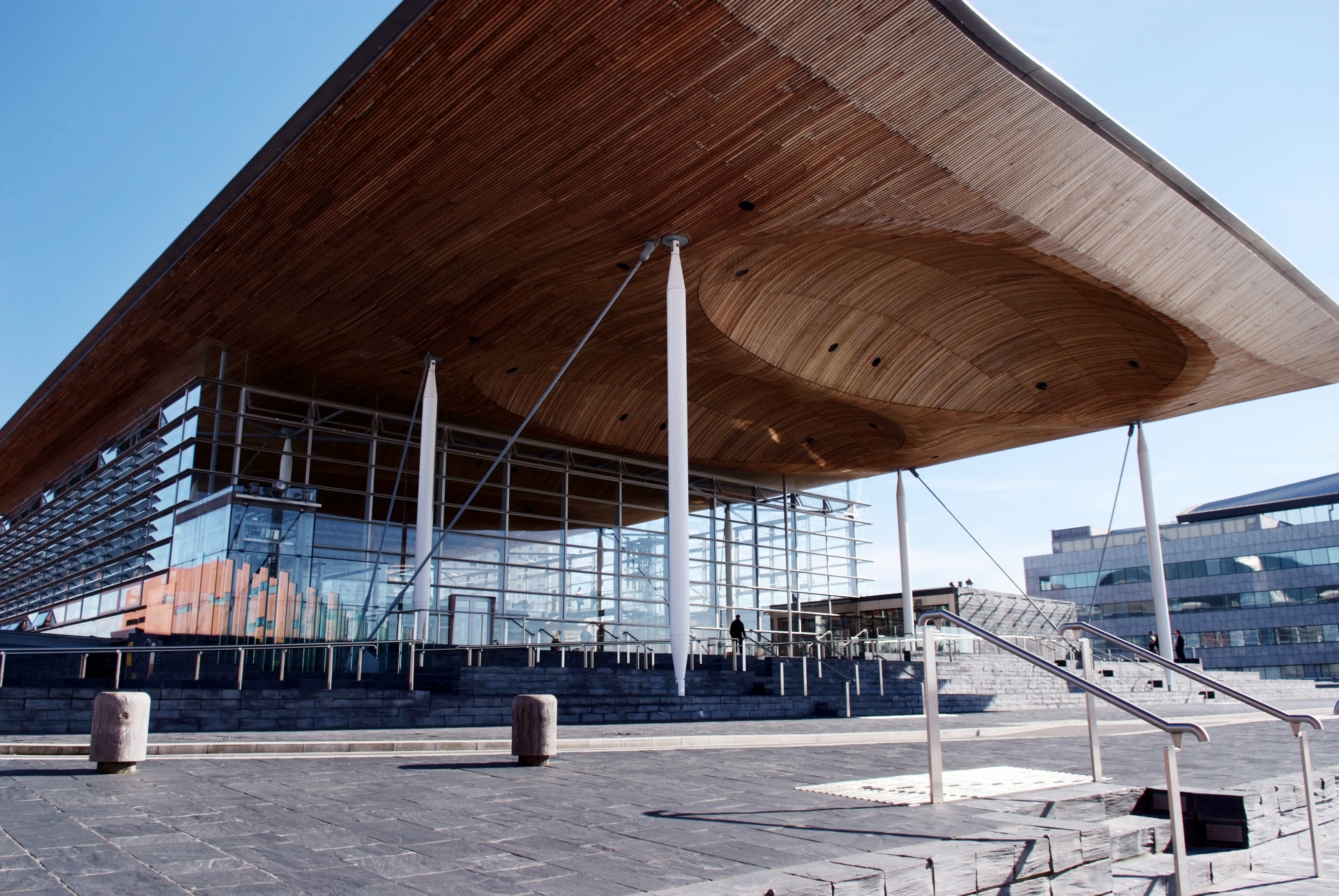 |
| Photo: Cardiff University |
The Senedd is not just a building for Members, it is your building.
It is the main public building of the Welsh Parliament, the main centre for democracy and devolution in Wales. It is an open building – a building into which you can walk, have a cup of coffee in the Oriel on the upper level, and go into the public galleries from the Neuadd on the centre level. And it is not just visitors that come here to see and enjoy the Senedd – we have also had performers, singers, exhibitions and all sorts of activities going on here, because it is a public building.
It is also a sustainable building, built of traditional Welsh materials such as slate and Welsh oak and other sustainable materials. It is also sustainable in the way it is heated; for example, the earth exchange system uses heat from the bottom of the old dock, on which the Senedd stands, before it became the area which is now Cardiff Bay. This is what this building represents. It represents sustainability, it represents democracy but it's more than that too – it is the symbol of the new nation that Wales has become. I hope you enjoy your visit to this site and that you will realise its value for you. This is Welsh democracy in action – this is devolution and it is yours!
14. Hungarian Parliament, Hungary
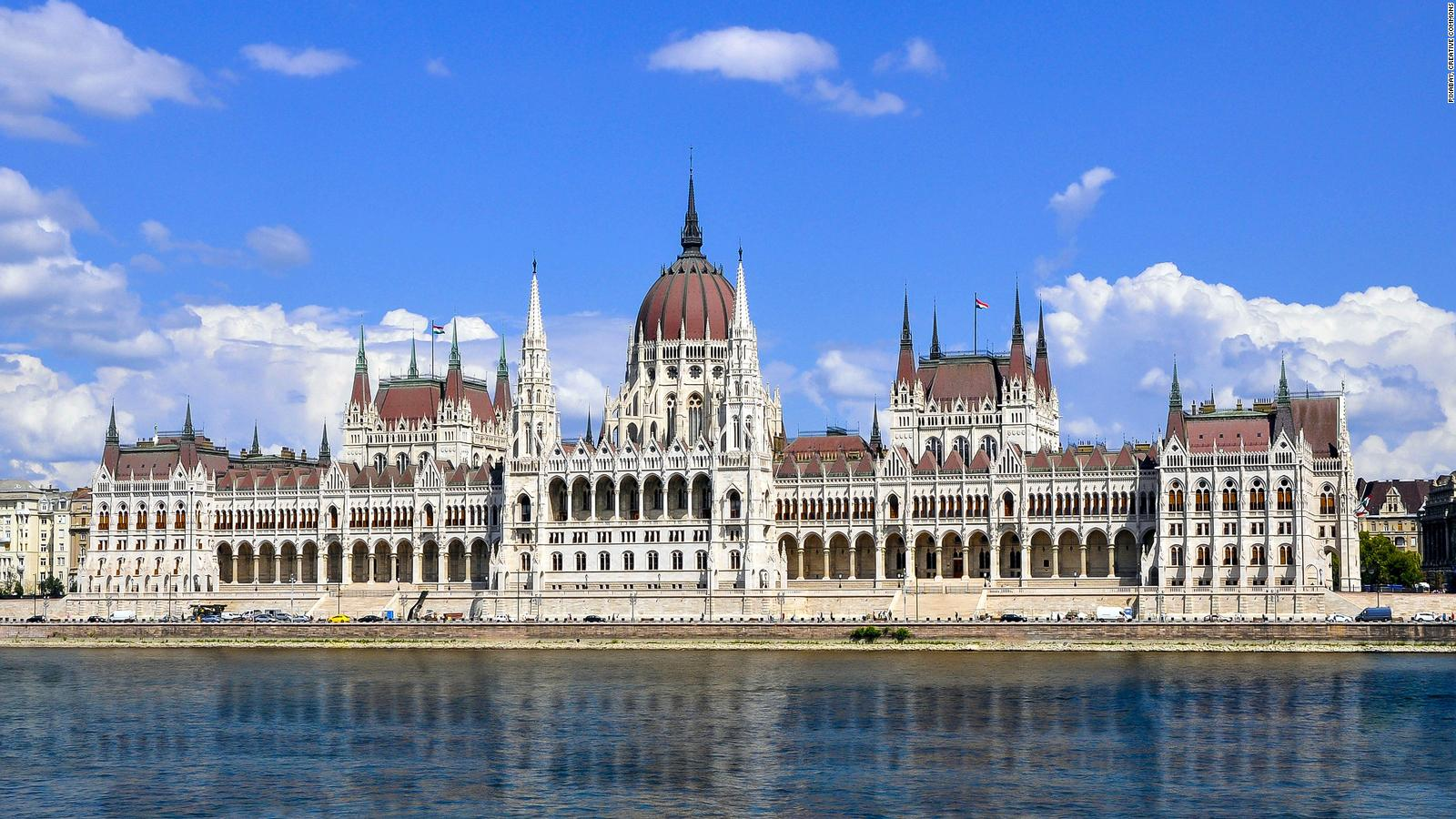 |
| Photo: CNN |
Although many call this fascinating building the Parliament, the correct name is actually the House of Parliament. Building this impressive edifice took 17 years, from 1885 to 1902, based on the design by the architect Imre Steindl. Unfortunately, the designer himself did not live to see the inauguration, since he died five weeks before. A vital stipulation for the construction project was that only Hungarian raw materials could be used for building the Hungarian Parliament and that it must involve Hungarian craftsmen and manufacturers, right up to the flora indigenous to the Carpathian Basin used for decoration. These terms were fulfilled, with only the gigantic granite columns imported from abroad. (An interesting point to note: only 12 of these columns have ever been made in the world – eight are in the House of Parliament, while the other four are in Britain.) Some of the figures are astonishing: roughly 40 million bricks were used for the construction, while about 40 kilograms of 22-23 carat gold embellish the Parliament. The floor area of the building is 18,000 square metres; 90 stone statues adorn the facade and there are around 162 more figures inside. The red carpet inside is almost 3 km long; you can enter through a total of 27 gates, and 365 towers of varying sizes, one for each day of the year, rise from the Hungarian Parliament.
13. Florence Cathedral, Italy
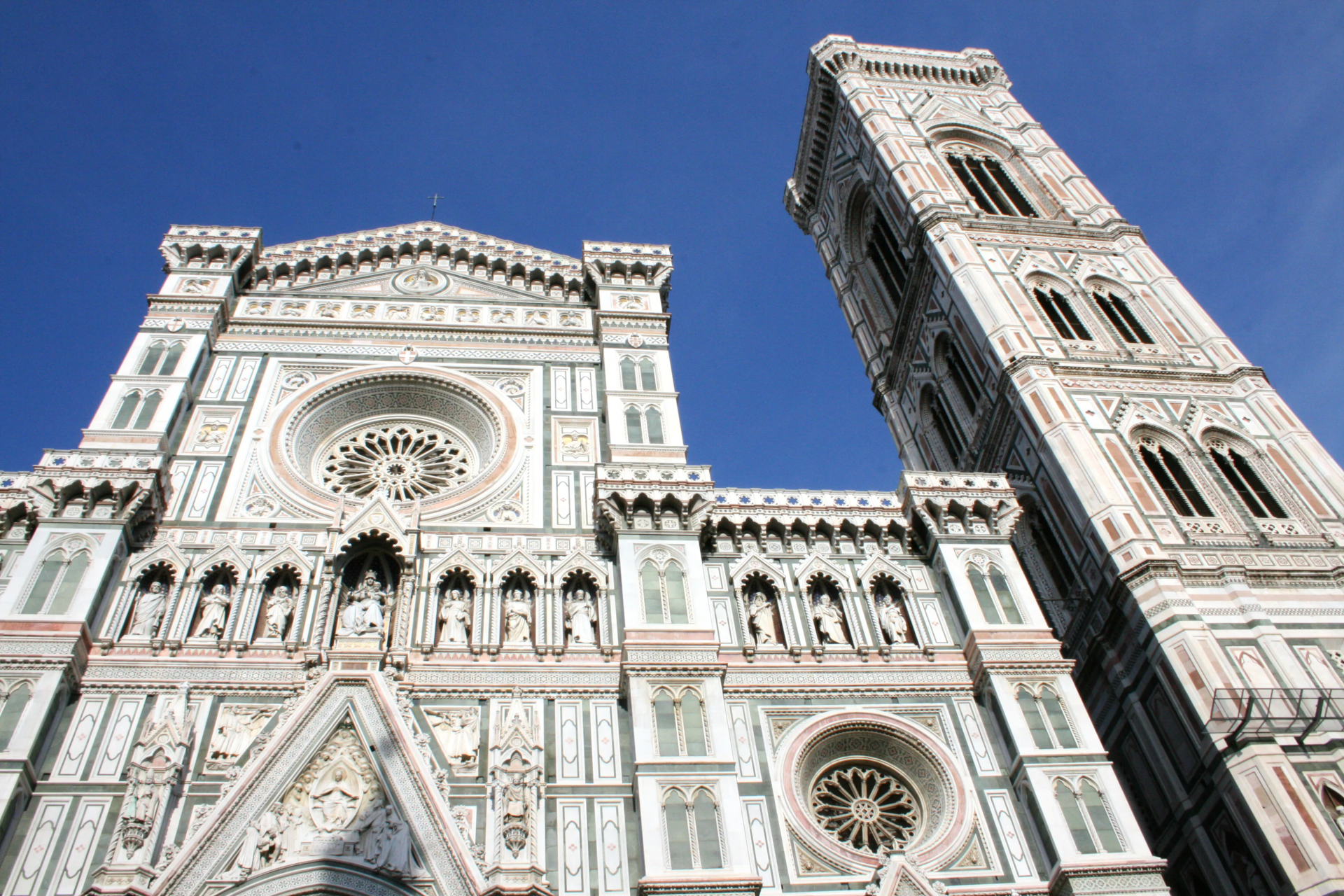 |
| Photo: Visitflorence |
The typical Italian Gothic building, the Cathedral of Florence, is dedicated to "Santa Maria del Fiore". The church was designed by Arnolfo di Cambio (c1245-1302) who considerably enlarged the existing religious structure. Finished around 1367, the Cathedral was completely covered by coloured marbles like the earlier Baptistery, except for the façade that remained unfinished and was terminated only in the 19th century.
The project left unfinished also the Dome, since in 1421 only the frame (polygonal base) had been erected. Two architects, Lorenzo Ghiberti (1368-1445) and Filippo Brunelleschi (1377-1446) won the competition although it was the latter who actually built the dome, showing a great mastery of technical knowledge, in 1436.
One of the most remarkable features of the outside of the building is the socalled "Porta della Mandorla"(north) (della mandorla = almond) that was given this name because of the large aureole around the figure of the Virgin sculptured also by Nanni di Banco (1380/90-1421) among others.
Its interior preserves very important works of art: on the left side we find the first two detached frescoes showing the "Condottiero Giovanni Acuto"and "Niccolò da Tolentino" painted respectively by Paolo Uccello in 1436 and by Andrea del Castagno in 1456. Paolo Uccello also frescoed the clock on the inside wall, showing four vogorous "heads of saints".
12. Notre Dame de Paris, France
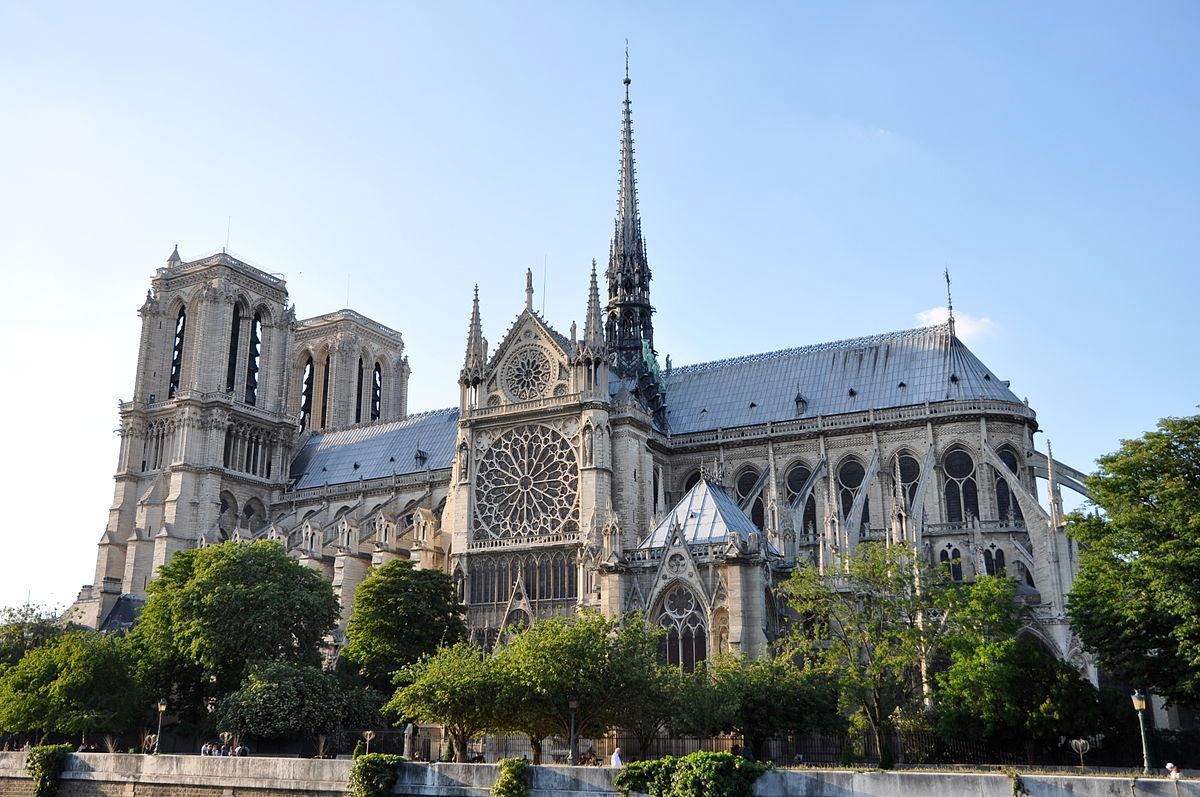 |
| Photo: Wikipedia |
Notre-Dame de Paris, also called Notre-Dame Cathedral, cathedral church in Paris. It is the most famous of the Gothic cathedrals of the Middle Ages and is distinguished for its size, antiquity, and architectural interest.
Notre-Dame lies at the eastern end of the Île de la Cité and was built on the ruins of two earlier churches, which were themselves predated by a Gallo-Roman temple dedicated to Jupiter. The cathedral was initiated by Maurice de Sully, bishop of Paris, who about 1160 conceived the idea of converting into a single building, on a larger scale, the ruins of the two earlier basilicas. The foundation stone was laid by Pope Alexander III in 1163, and the high altar was consecrated in 1189. The choir, the western facade, and the nave were completed by 1250, and porches, chapels, and other embellishments were added over the next 100 years.
11. The Louvre Museum, France
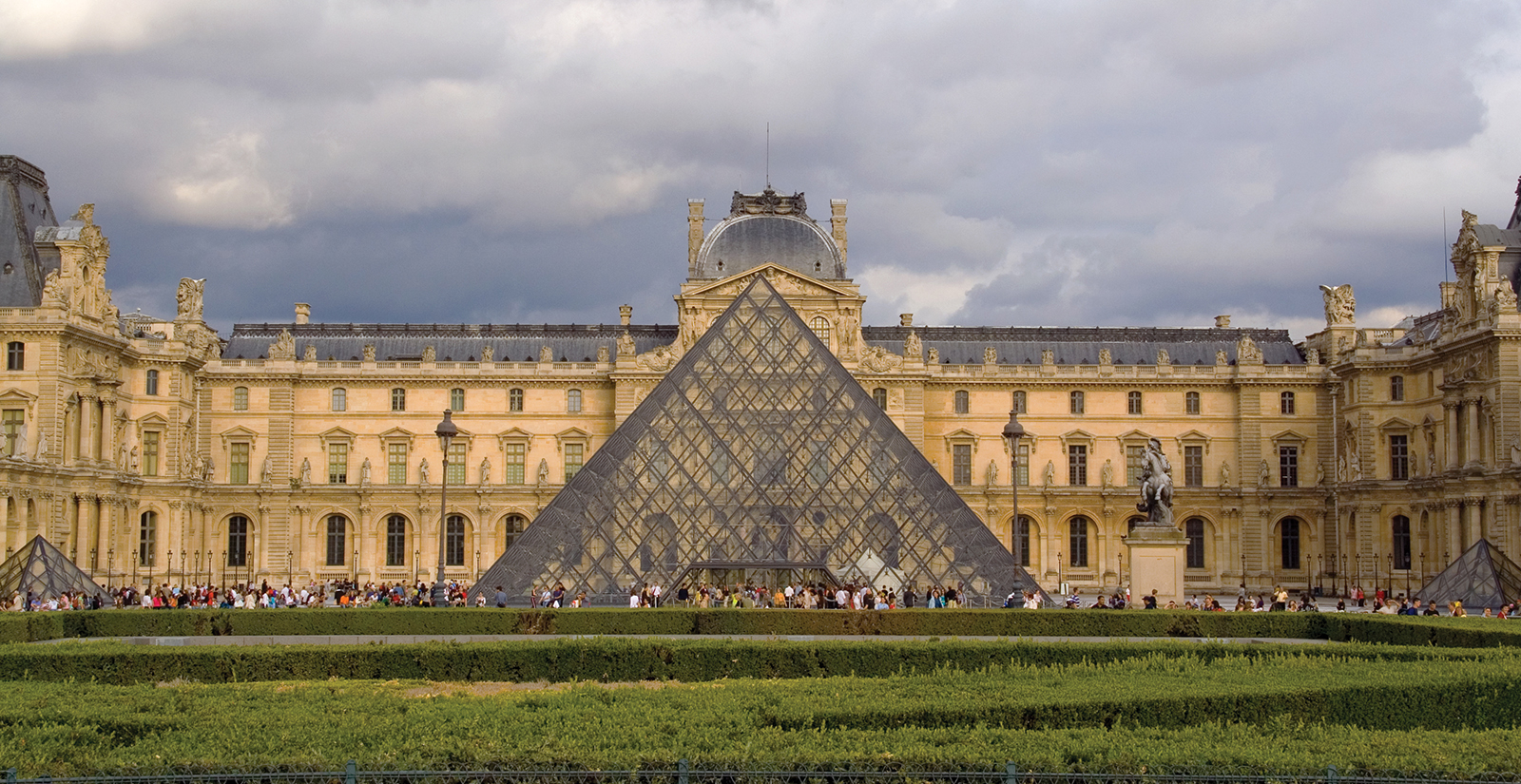 |
| Photo: Wikipedia |
The Louvre was originally built as a fortress in 1190, but was reconstructed in the 16th century to serve as a royal palace. "Like many buildings, it was built and rebuilt over the years," said Tea Gudek Snajdar, an Amsterdam-based art historian, museum docent and a blogger at Culture Tourist.
During its time as a royal residence, the Louvre saw tremendous growth. Nearly every monarch expanded it, according to History.com. Today, it covers a total area of 652,300 square feet (60,600 square meters). In 1682, Louis XIV moved the royal residence to Versailles, and the Louvre became home to various art academies, offering regular exhibitions of its members' works.
During the French Revolution, Louis XVI and his wife, Marie Antoinette, were forcibly removed from Versailles and imprisoned in Tuilleries Palace, which was then adjacent to the Louvre, according to the Louvre’s official website. They were beheaded there in 1793.
The Louvre's collection includes Egyptian antiques, ancient Greek and Roman sculptures, paintings by the Old Masters (notable European artists from before 1800), and crown jewels and other artifacts from French nobles. Its works span the sixth century B.C. to the 19th century A.D. More than 35,000 works are on display at any given time. The displays are divided into eight departments: Near Eastern Antiquities; Egyptian Antiquities; Greek, Etruscan and Roman Antiquities; Islamic Art; Sculptures; Decorative Arts; Paintings; and Prints and Drawings, according to the Louvre website.
10. Schwerin Palace, Germany
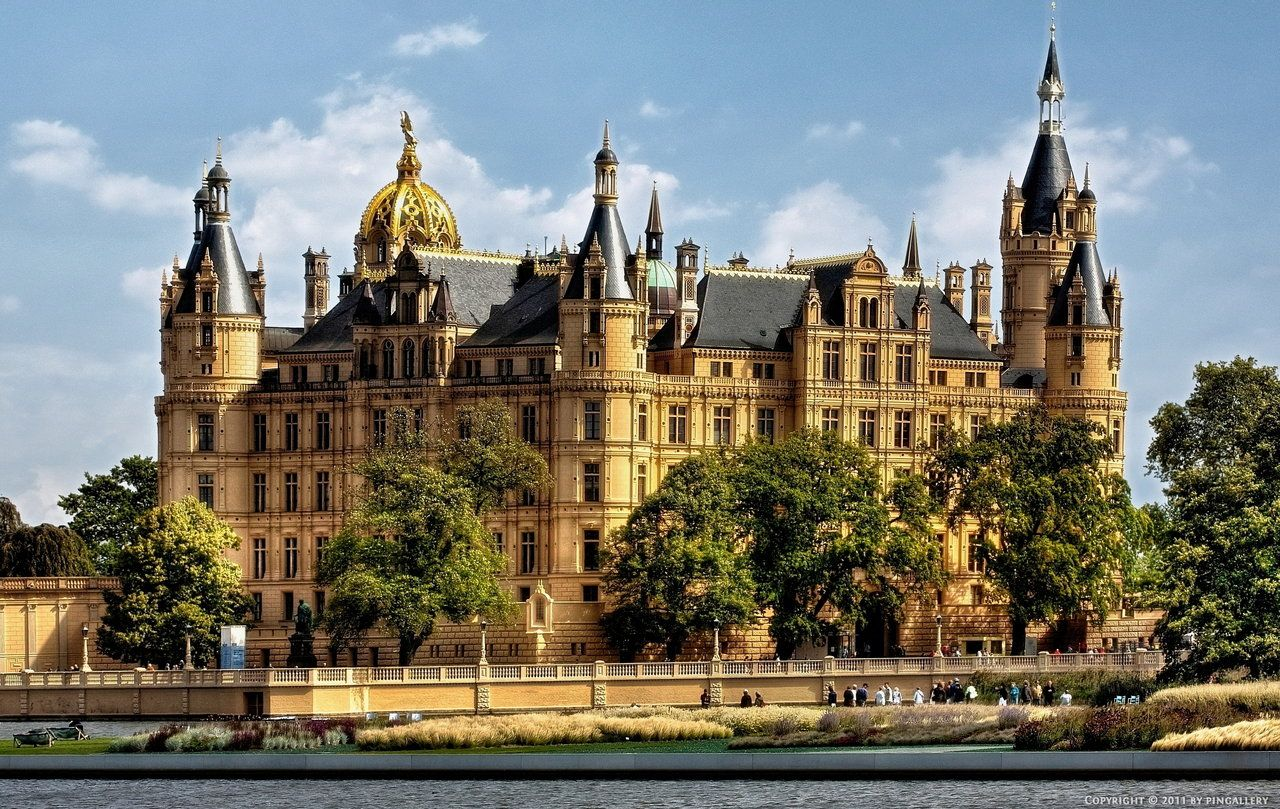 |
| Photo: Pinterest |
Situated in a romantic spot on an island in Lake Schwerin, Schwerin Castle is one of the finest examples of historicism in Europe. Although its roots go back more than 1,000 years, the castle was brought to life in its current form with five wings when Frederick Francis II, the Grand Duke of Mecklenburg-Schwerin, ordered for reconstruction work to be completed. The magnificent building has no fewer than 653 rooms, which are decadently filled with marquetry flooring, intricate carvings, gilding and stucco ceilings.
Highlights include the throne room with columns made from Carrara marble and gilded cast-iron doors, the ancestral portrait gallery, the dining room and the round tower room, which is designed as a garden room and offers up a panoramic view across the lake. A remarkable porcelain collection and regular concerts at the castle make for further attractions not to be missed. And yet what makes the castle complex truly special is its perfect symbiosis with the splendid baroque garden, where there is an orangery, a grotto and the colonnade courtyard surrounding the castle.
9. Parthenon, Greece
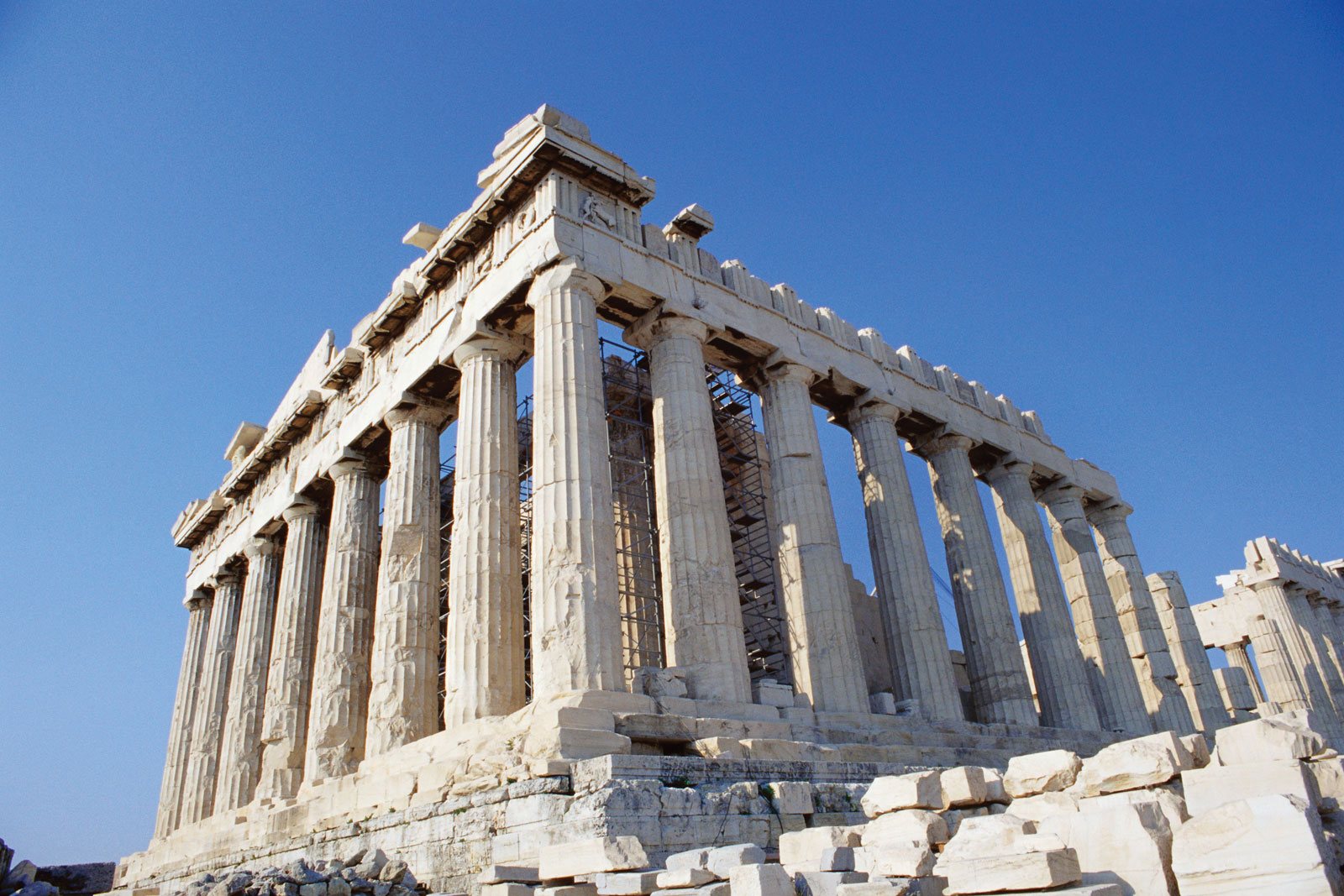 |
| Photo: Britannica |
Parthenon, temple that dominates the hill of the Acropolis at Athens. It was built in the mid-5th century BCE and dedicated to the Greek goddess Athena Parthenos (“Athena the Virgin”). The temple is generally considered to be the culmination of the development of the Doric order, the simplest of the three Classical Greek architectural orders.
Directed by the Athenian statesman Pericles, the Parthenon was built by the architects Ictinus and Callicrates under the supervision of the sculptor Phidias. Work began in 447 BCE, and the building itself was completed by 438. The same year a great gold and ivory statue of Athena, made by Phidias for the interior, was dedicated. Work on the exterior decoration of the building continued until 432 BCE.
Although the rectangular white marble Parthenon has suffered damage over the centuries, including the loss of most of its sculpture, its basic structure has remained intact. A colonnade of fluted, baseless columns with square capitals stands on a three-stepped base and supports an entablature, or roof structure, consisting of a plain architrave, or band of stone; a frieze of alternating triglyphs (vertically grooved blocks) and metopes (plain blocks with relief sculpture, now partly removed); and, at the east and west ends, a low triangular pediment, also with relief sculpture (now mostly removed). The colonnade, consisting of 8 columns on the east and west and 17 on the north and south, encloses a walled interior rectangular chamber, or cella, originally divided into three aisles by two smaller Doric colonnades closed at the west end just behind the great cult statue. The only light came through the east doorway, except for some that might have filtered through the marble tiles in the roof and ceiling. Behind the cella, but not originally connected with it, is a smaller, square chamber entered from the west. The east and west ends of the interior of the building are each faced by a portico of six columns. Measured by the top step of the base, the building is 101.34 feet (30.89 metres) wide and 228.14 feet (69.54 metres) long.
8. Freebooter, Netherlands
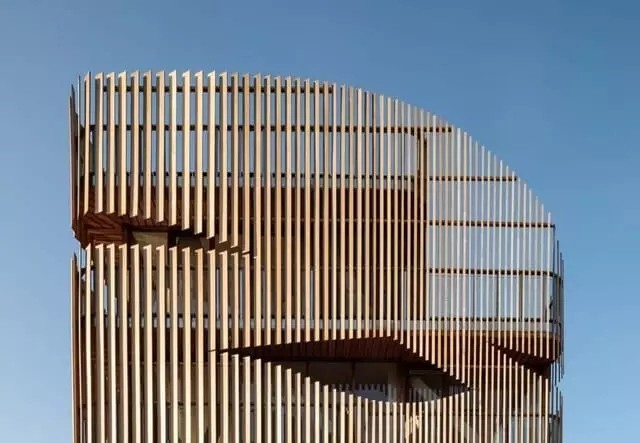 |
| Photo: Getty Images |
The modernist Freebooter, in Amsterdam, is an apartment complex build in 2019 by the Amsterdam-based studio-loop. The most interesting feature about the building is the fact that it’s made of timbers displayed in a parametric shape, which allows sunlight to flood the apartments while at the same time maintaining the privacy of the inhabitants.
7. Saint Basil’s Cathedral, Russia
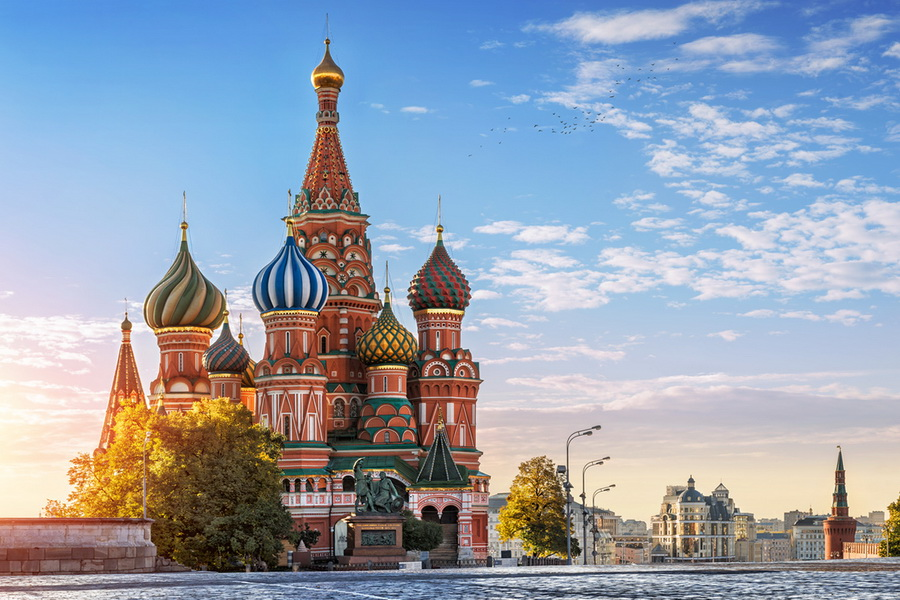 |
| Photo: Advantour |
The Cathedral of the Intercession of the Virgin on the Moat is better known as the Cathedral of Saint Basil the Blessed: St Basil's Cathedral. It is the most recognizable church in Russia.
St Basil's Cathedral was built in the 16th century by the order of Ivan the Terrible. Since then, it has fascinated travelers coming to Moscow. Some found it bizarre; its unusual beauty entranced others.
The church is shrouded in legends and myths. People say that the cruel Russian tsar had the architect blinded to prevent him from building a more magnificent building for anyone else. Legend has it that Napoleon wanted to destroy the Cathedral when he realized he couldn't relocate it to Paris.
The Cathedral was commissioned by Ivan the Terrible to commemorate the capture of the Khanate of Kazan. It was constructed from 1555 to 1561.
Saint Basil's is a cluster of buildings - a central church surrounded by nine auxiliary churches, eight dedicated to Ivan's eight victories over the Tatars, and a smaller one consecrated to Saint Basil. This famous Moscow saint was buried in the grounds, and his name later became the name of the Cathedral.
According to chronicles from the time, St Basil's Cathedral was designed by two Russian architects: Barma and Postnik. Another theory suggests that Yakovlev and Barma were one person. Many serious Russian historians believe that architects were not blinded and went to construct more churches in Russia.
The third version says that the temple was erected under the guidance of an architect from Western Europe. The unusual composition of St. Basil's Cathedral and a blend of Russian and Western European elements of decoration prove that there was a distinctive influence from abroad. The last version, however, has no proof in chronicles.
St Basil's Cathedral on Red Square remains the most unusual church in Russia and has become an enigmatic symbol of Moscow itself, surviving the Revolution and Soviet times.
6. Tower of Pisa, Italy
 |
| Photo: Wikipedia |
Tower of Pisa is more accurately referred to simply as the bell tower, or campanile.
The Pisa tower is one of the four buildings that make up the cathedral complex in Pisa, Italy, called Campo dei Miracoli or Piazza dei Miracoli, which means Field of Miracles.
The first building constructed at Campo dei Miracoli, Pisa, was the cathedral, or Duomo di Pisa, which rests on a white marble pavement and is an impressive example of Romanesque architecture.
The next building added was the baptistery just west of the dome.Then work on the campanile began. Before the work on the campanile was completed the cemetery, Campo Santo, was built.
Piazza dei Miracoli of Pisa is the most splendiferous assemblage of Romanesque architecture in Italy. Faced in gray-and-white striped marble and bristling with columns and arches, the cathedral, with its curiously Islamic dome and matching domed baptistery, rises from an emerald green lawn.
Flanking one side of the piazza, the camposanto, or cemetery, is a gracefully elongated cloister enclosing a burial ground with earth reputedly brought back during the Crusades from Golgotha, the hill where Jesus was crucified, so that noble Pisans could rest in holy ground.
5. Lotus Temple, India
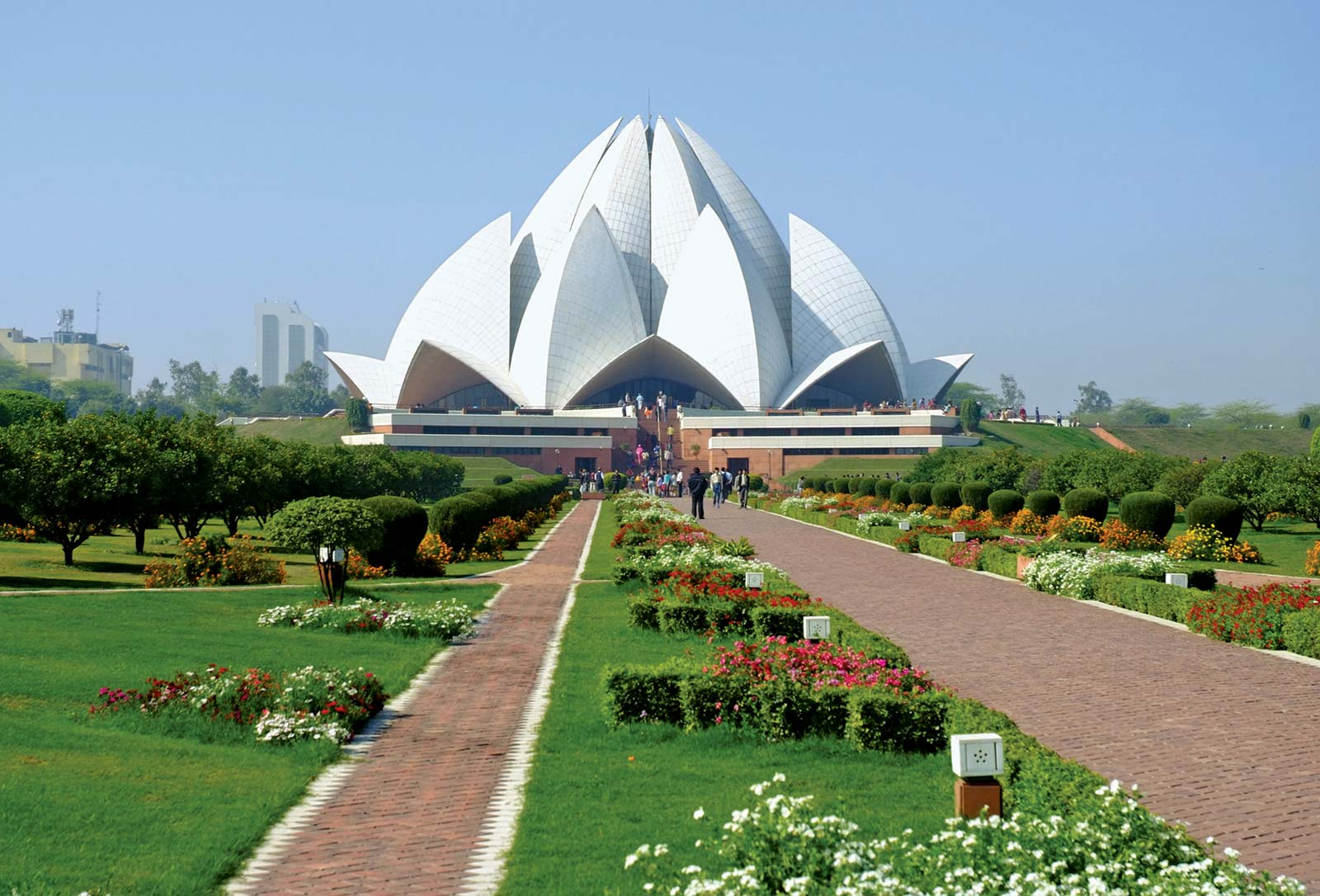 |
| Photo: Britannica |
Lotus Temple, Bahāʾī Faith house of worship, or mashriq al-adhkār (Arabic: “a place where the uttering of the name of God arises at dawn”), in New Delhi. In the early 21st century it was one of only nine mashriqs in the world.
The Lotus Temple was consecrated and opened to the public in December 1986. It was designed by Iranian architect Fariborz Sahba, who won acclaim for the project even before the temple was completed. It subsequently received several awards.
The Lotus Temple derives its name from its design. Like every other Bahāʾī mashriq, it is characterized by a nine-sided construction, in keeping with the Bahāʾī belief in the mystical properties of the number nine. Set on an elevated plinth in a 26-acre (10.5-hectare) expanse of landscaped gardens and surrounded by nine pools bordered by red sandstone walkways, the white marble edifice rises to a height of more than 130 feet (40 metres). The temple complex comprises 27 independent marble “petals,” which are clustered into groups of three to form nine sides (through which open nine entrances into a central space) and into groups of nine to form three concentric rings. Petals in the first ring face outward, forming canopies over the nine entrances. The second ring covers the outer hall. In the innermost ring, the petals curve inward to partially enclose the central prayer hall, which accommodates about 2,500 people. The top of the structure appears open but actually contains a glass-and-steel roof that admits natural daylight. The overall effect is that of a floating lotus flower on the verge of blooming and surrounded by its leaves.
4. Cologne Cathedral, Germany
 |
| Photo: solosophia |
Cologne Cathedral, German Kölner Dom, Roman Catholic cathedral church, located in the city of Cologne, Germany. It is the largest Gothic church in northern Europe and features immense twin towers that stand 515 feet (157 metres) tall. The cathedral was designated a UNESCO World Heritage Site in 1996.
The site of Cologne Cathedral has been occupied by Christian churches since about the 4th century. An older cathedral was destroyed by fire in 1248, and immediately thereafter work began on the present cathedral, which was designed in the Gothic style in emulation of French church architecture. The choir was consecrated in 1322, but construction continued until 1560 (or only until 1520, according to some authorities). The project then stalled for centuries, with a large wooden crane left standing some 184 feet (56 metres) above the ground, at the top of the south tower. During the 1790s, troops of the French Revolution occupied Cologne and used the cathedral as a stable and a hay barn. Restoration work began in the 1820s, spurred on by Sulpiz Boisserée, a German proponent of the Gothic Revival movement. In 1842 a new cornerstone was laid by King Frederick William IV of Prussia, and work to complete the cathedral resumed in earnest. The architects Ernst Friedrich Zwirner and Richard Voigtel carried out the enterprise, guided by architectural drawings made in about 1300. Construction finally ended in 1880.
3. Winter Palace, Russia
 |
| Photo: Saint Petersburg |
St. Petersburg's most famous building, the Winter Palace not only physically dominates Palace Square and the south embankment of the Neva River, but also plays a central political, symbolic, and cultural role in the three-century history of the city.
The first Imperial residence on the site of the Winter Palace was a wooden house in the Dutch style built in 1708 for Peter the Great and his family. This was replaced in 1711 by a stone building, the remains of which formed the foundations of the Hermitage Theatre. Parts of this original palace have now been restored and are open to the public.
Empress Anna Ioannovna was the first of Peter's descendants to reconstruct the palace. In 1731, she commissioned Francesco Bartolomeo Rastrelli, the recently appointed court architect who would go on to become the recognized master of late baroque in Russia, to create a new, larger palace on the site. Completed in 1735, the third Winter Palace served for only 17 years before Rastrelli was again asked, this time by Empress Elizabeth (Elizaveta Petrovna), to expand the building. After two years proposing different plans to adapt the existing building, Rastrelli eventually decided to completely rebuild the palace, and his new design was confirmed by the empress in 1754.
2. Burj Khalifa, Dubai
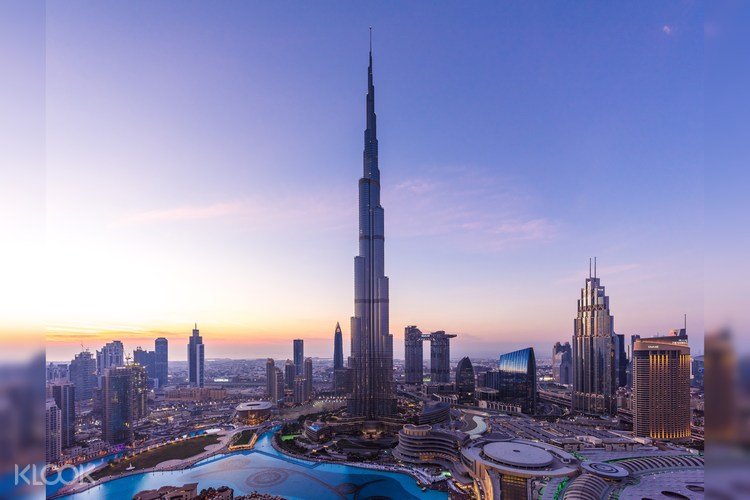 |
| Photo: Klook |
The Burj Khalifa, known as the Burj Dubai prior to its inauguration in 2010, is a skyscraper in Dubai, United Arab Emirates. With a total height of 829.8 m (2,722 ft, just over half a mile) and a roof height (excluding antenna, but including a 244 m spire) of 828 m (2,717 ft), the Burj Khalifa has been the tallest structure and building in the world since its topping out in 2009, supplanting Taipei 101, the previous holder of that status.
Construction of the Burj Khalifa began in 2004, with the exterior completed five years later in 2009. The primary structure is reinforced concrete and some of the structural steel for the building originated from the Palace of the Republic in East Berlin, the former East German parliament. The building was opened in 2010 as part of a new development called Downtown Dubai. It is designed to be the centrepiece of large-scale, mixed-use development. The decision to construct the building is based on the government's decision to diversify from an oil-based economy, and for Dubai to gain international recognition. The building was originally named Burj Dubai but was renamed in honour of the ruler of Abu Dhabi and president of the United Arab Emirates, Khalifa bin Zayed Al Nahyan; Abu Dhabi and the UAE government lent Dubai money to pay its debts. The building broke numerous height records, including its designation as the tallest building in the world.
1. Metropolitan Cathedral of Brasília, Brazil
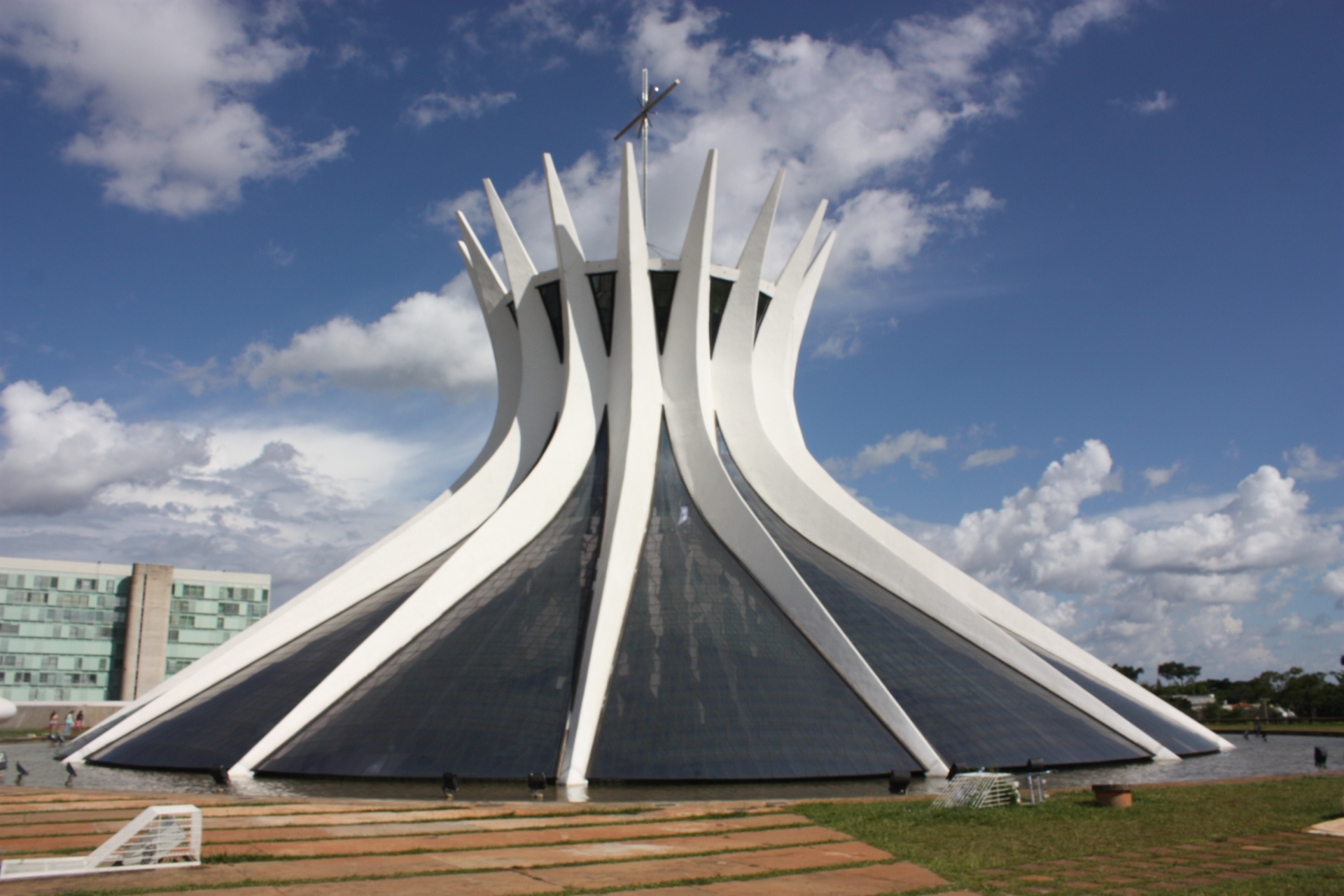 |
| Photo: Pinterest |
Surrounded with symbolism, like any religious building, the Cathedral of Brasilia – whose official name is Catedral Metropolitana Nossa Senhora Aparecida – is one of the most expressive pieces in the capital. It is located in a secondary area of the master plan, showing that, unlike in the colonial period, during which religious structures had strategic positions in Brazilian cities, the Catholic Church no longer represented one of the central powers in Brazil, the country with the largest Catholic population.
Though the architect is a professed atheist, the space conveys religious emotion and is at once spectacular and simple, strengthened by an access in promenade architecturale: a dark tunnel leads the visitor to the interior of the circular aisle of 70 meters in diameter, at a lower height with respect to the exterior level; with the pupil dilated by darkness, the visitor walks some meters in the direction of light – almost as if metaphorically they were entering in search of spirituality – and, when they finally reach the cathedral proper, which is in essence a concrete and glass dome bathed by light, the visitor’s eye opens up to a magical space. The sixteen structural pieces of concrete of the roof – which, symbolically, can refer to the idea of the crown of thorns of Christ – have a parabolic section, and rest one upon the other leaving space between glass-filled columns. Given the difficulty in sealing the glass sheets, the cathedral was unfinished for years and, still, the image of the structure has appeared on the cover of dozens of architectural publications.
 Top 20 Fastest Growing Jobs In The US Top 20 Fastest Growing Jobs In The US The U.S. has been a great field for works and opportunity. Here is our list of top 20 fastest growing jobs in the US and ... |
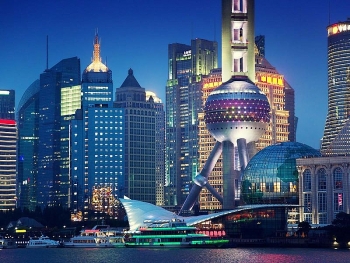 Surprising Facts 'Top 20 Most Expensive Cities' To Live in the World Surprising Facts 'Top 20 Most Expensive Cities' To Live in the World The Mercer Cost of Living Survey 2021 has named a somewhat surprising list as the top most expensive cities to live in the world. |
 Top 20 Best Poems For Father's Day Top 20 Best Poems For Father's Day Father is one of the most important people in your life, and you want to send the best wishes and loving words to your father ... |
 Who Is Erica Fernandes: Biography, Career, Personal Life and 20 Most Desirable Women on TV Who Is Erica Fernandes: Biography, Career, Personal Life and 20 Most Desirable Women on TV Erica Fernandes has been voted as the most desirable women on TV in 2020. Keep reading the article below to know more about her career, ... |


























